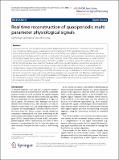Real time reconstruction of quasiperiodic multi parameter physiological signals
Author(s)
Ganeshapillai, Gartheeban; Guttag, John V.
Download1687-6180-2012-173.pdf (4.224Mb)
OPEN_ACCESS_POLICY
Open Access Policy
Creative Commons Attribution-Noncommercial-Share Alike
Terms of use
Metadata
Show full item recordAbstract
A modern intensive care unit (ICU) has automated analysis systems that depend on continuous uninterrupted real time monitoring of physiological signals such as electrocardiogram (ECG), arterial blood pressure (ABP), and photo-plethysmogram (PPG). These signals are often corrupted by noise, artifacts, and missing data. We present an automated learning framework for real time reconstruction of corrupted multi-parameter nonstationary quasiperiodic physiological signals. The key idea is to learn a patient-specific model of the relationships between signals, and then reconstruct corrupted segments using the information available in correlated signals. We evaluated our method on MIT-BIH arrhythmia data, a two-channel ECG dataset with many clinically significant arrhythmias, and on the CinC challenge 2010 data, a multi-parameter dataset containing ECG, ABP, and PPG. For each, we evaluated both the residual distance between the original signals and the reconstructed signals, and the performance of a heartbeat classifier on a reconstructed ECG signal. At an SNR of 0 dB, the average residual distance on the CinC data was roughly 3% of the energy in the signal, and on the arrhythmia database it was roughly 16%. The difference is attributable to the large amount of diversity in the arrhythmia database. Remarkably, despite the relatively high residual difference, the classification accuracy on the arrhythmia database was still 98%, indicating that our method restored the physiologically important aspects of the signal.
Date issued
2012-08Department
Massachusetts Institute of Technology. Computer Science and Artificial Intelligence Laboratory; Massachusetts Institute of Technology. Department of Electrical Engineering and Computer ScienceJournal
EURASIP Journal on Advances in Signal Processing
Publisher
Springer Science + Business Media B.V.
Citation
Ganeshapillai, Gartheeban, and John Guttag. “Real Time Reconstruction of Quasiperiodic Multi Parameter Physiological Signals.” EURASIP Journal on Advances in Signal Processing 2012.1 (2012): 173. CrossRef. Web.
Version: Author's final manuscript
ISSN
1687-6172
1687-6180